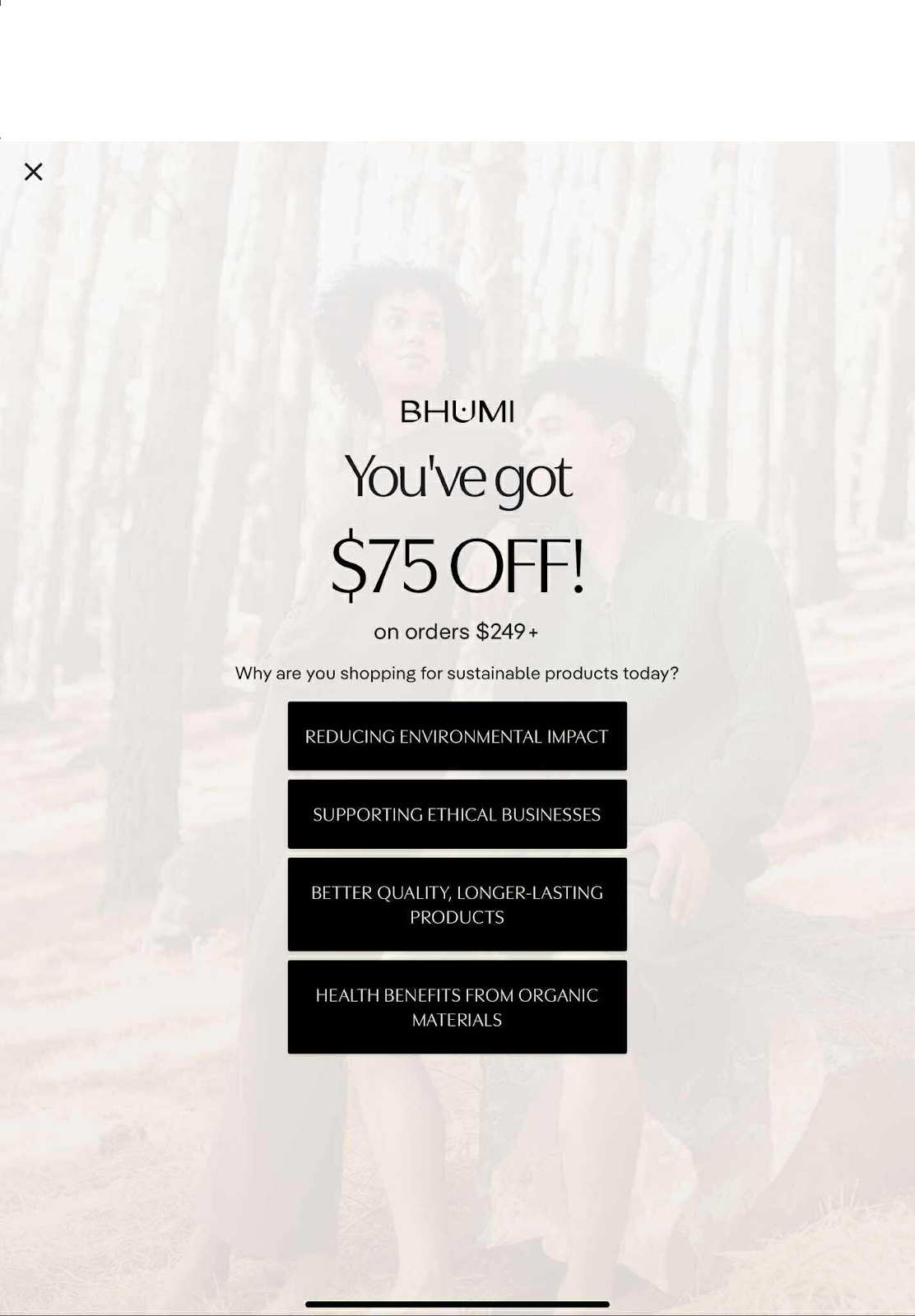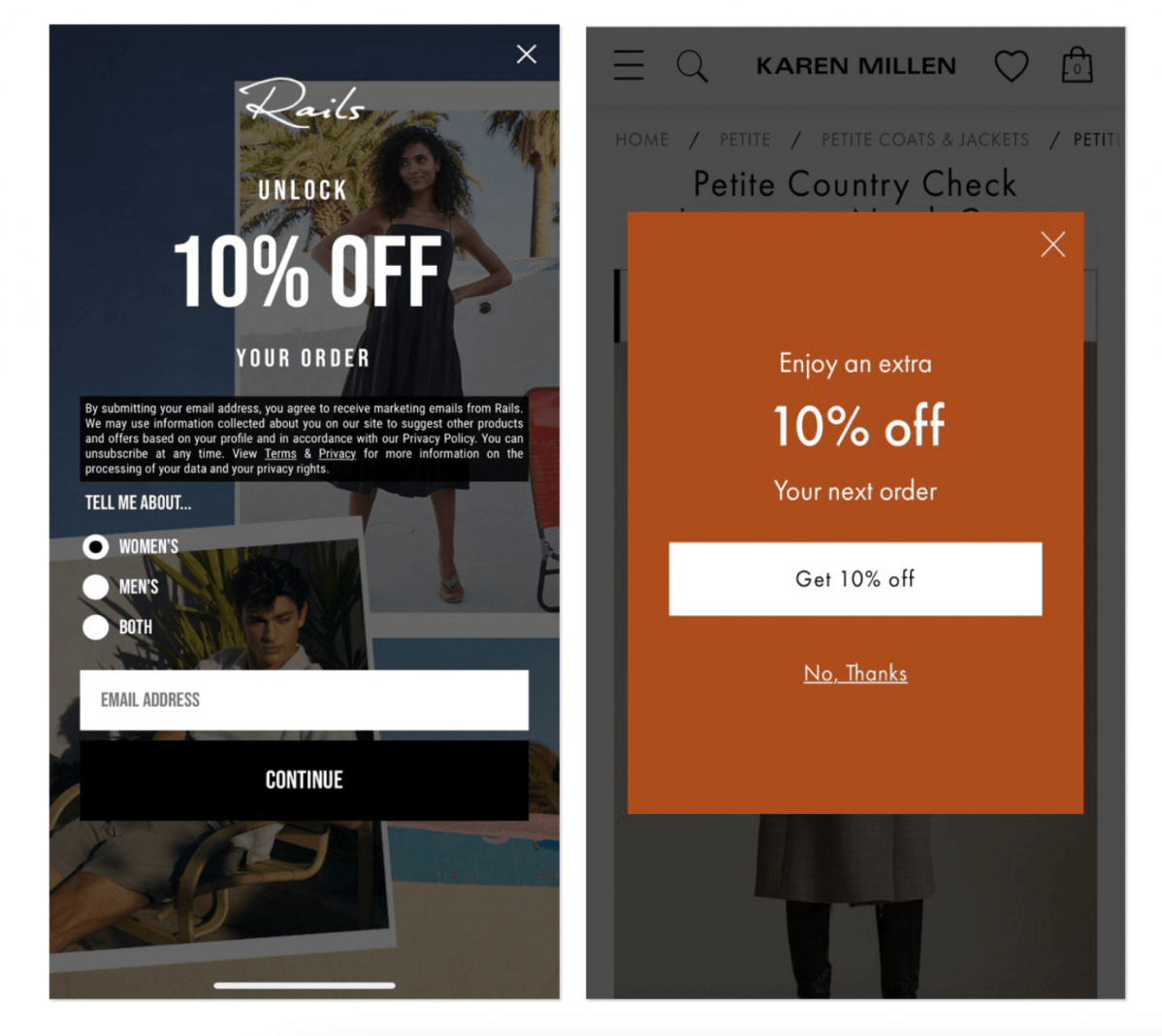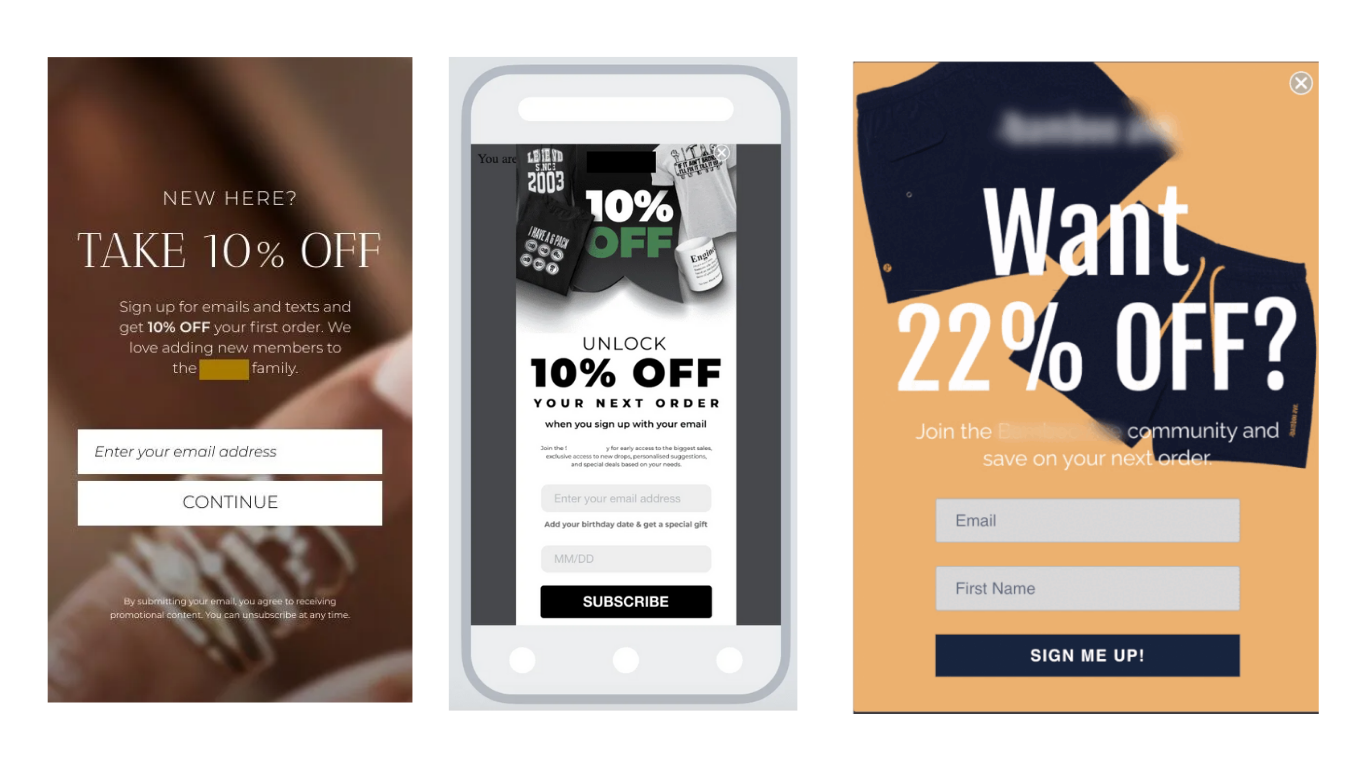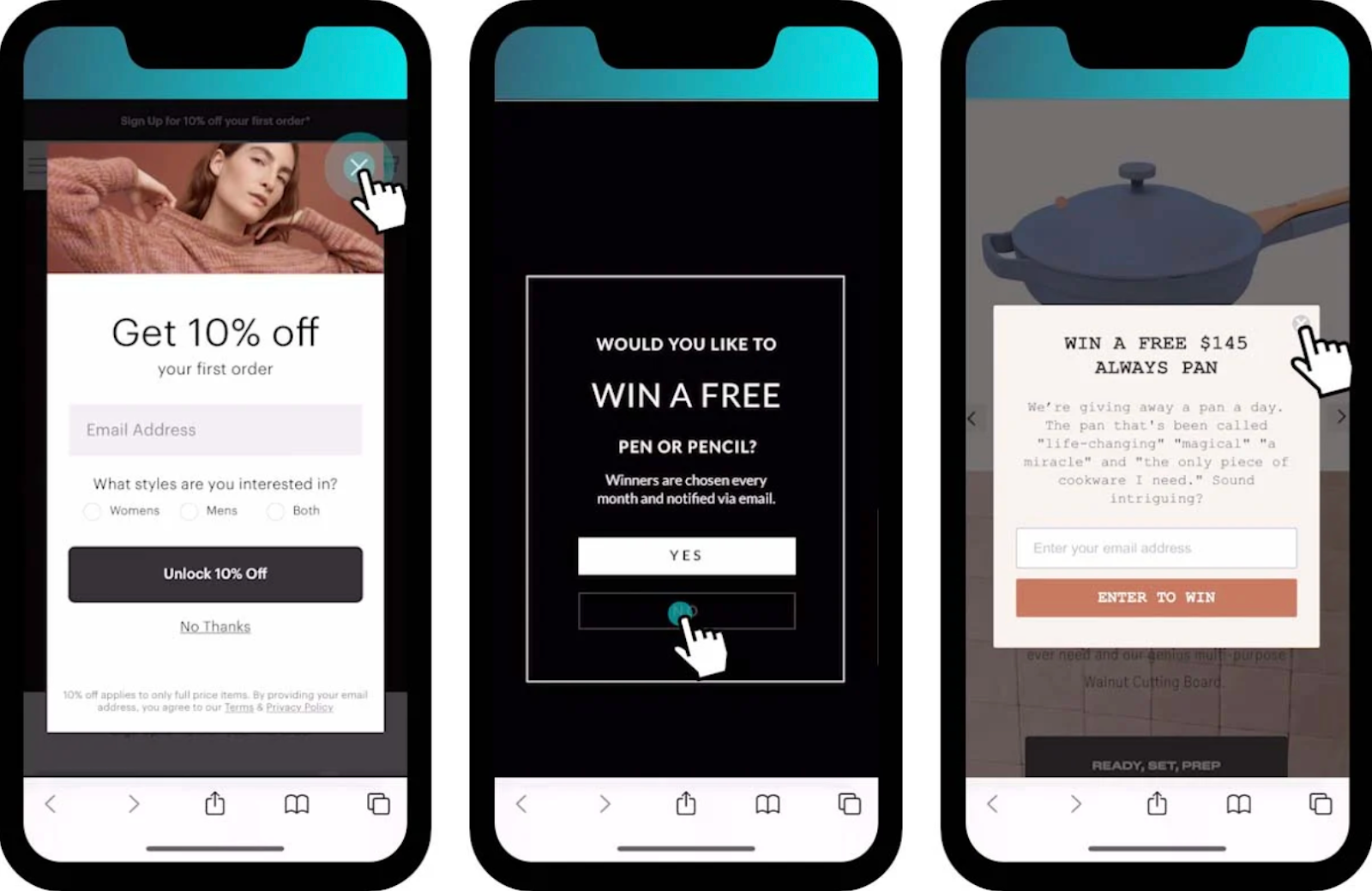Mobile popups are interactive overlays designed specifically for mobile devices to capture leads, promote offers, and reduce cart abandonment.
When executed correctly, mobile popups can increase email signups by 15-35% while maintaining positive user experience.
However, poor mobile popup implementation can harm conversions and SEO rankings due to Google's mobile interstitial penalties.
TL;DR
- Mobile-first design is critical — 60% of traffic is mobile, requiring specialized optimization with 90-95% screen width and 44px minimum touch targets
- Timing beats design — Proper triggers (50-70% scroll depth, exit intent) can improve conversions by 25-50% over immediate popups
- Less is more — Single email field outperforms complex forms by 20-30%, with each additional field reducing completion by 5-10%
- Test continuously — Mobile behavior changes rapidly, requiring ongoing A/B testing with 95% confidence levels and 2+ week durations
We reviewed all of this using Alia, so if you want to skip the guesswork and get AI-powered optimization that automatically finds your best-performing popup variants try Alia now and have your popups self-optimize in real time.
What Are Mobile Popups and Why They Matter

Mobile popups are specialized overlay windows that appear on smartphones and tablets to engage visitors at key moments.
Unlike desktop popups, mobile versions must account for limited screen real estate, touch navigation, and varying connection speeds.
The stakes are higher on mobile since 60% of ecommerce traffic now comes from mobile devices, making popup optimization critical for revenue growth.
The Mobile-Desktop Divide
Mobile users behave fundamentally differently than desktop users. They have shorter attention spans, use thumb navigation, and often browse in distracting environments.
This means mobile popups need to communicate value instantly and provide effortless interaction.
Google's Mobile Interstitial Guidelines
Google penalizes intrusive mobile interstitials that appear immediately upon page load or cover substantial content.
Safe practices include using popups triggered by user behavior (scroll depth, time on page) rather than immediate display. Exit-intent popups and small banners that don't obstruct content remain acceptable.
Revenue Impact
Well-designed mobile popups deliver measurable results. Nakie, an outdoor gear brand, increased their email opt-in rates from 5-6% to an average of 28% (peaking at 35%) after switching to mobile-optimized popups.
Their 24% purchase rate after signup demonstrates how proper implementation directly impacts revenue.
Mobile Popup Design Fundamentals

Effective mobile popup design requires balancing visibility with usability across screen sizes from 320px to 768px wide. The key is creating thumb-friendly interfaces that don't overwhelm the limited mobile viewport while still capturing attention and driving action.
Screen Size and Positioning Guidelines
Optimal Popup Dimensions:
- Width: 90-95% of screen width (maximum 400px to prevent overflow)
- Height: Never exceed 70% of viewport height to maintain content visibility
- Margins: 10-15px on all sides for visual breathing room
- Positioning: Center-aligned with consistent spacing across devices
Touch-Friendly Design: Mobile users navigate with their thumbs, creating natural interaction zones. Position critical elements within the bottom two-thirds of the popup where thumbs naturally reach. Keep interactive elements minimum 44px apart to prevent accidental taps.
Typography and Visual Hierarchy
Font Size Requirements:
- Headlines: 18-24px for immediate impact and readability
- Body text: 14-16px minimum (never below 12px for accessibility)
- Button text: 16-18px for clear call-to-action visibility
- Line height: 1.4-1.6 for comfortable reading on small screens
Contrast and Accessibility: Maintain minimum 4.5:1 contrast ratio for text readability. Use 7:1 ratio for optimal accessibility compliance. Test your color combinations across different devices and lighting conditions to ensure consistent visibility.
Call-to-Action Button Optimization
Technical Specifications:
- Minimum size: 44x44px (Apple's recommended touch target)
- Optimal placement: Bottom third of popup for natural thumb reach
- Color strategy: High contrast against background (7:1 ratio preferred)
- Text guidelines: Action-oriented, 2-4 words maximum
Proven Button Examples:
- "Get 15% Off" (clear value proposition)
- "Join Now" (immediate action)
- "Claim Discount" (urgency + benefit)
- "Start Saving" (outcome-focused)
MiHIGH achieved a 3x increase in opt-in rates (from 6% to 18%) using Alia's mobile-optimized design that prioritized touch-friendly interactions over traditional desktop-focused layouts.
Mobile Popup Timing and Triggers

Proper timing separates effective mobile popups from annoying interruptions. Mobile users have shorter attention spans and less patience for poorly timed overlays, making trigger optimization crucial for both conversions and user satisfaction.
Behavior-Based Triggers
Optimal Trigger Settings by Type:
Implementation Strategy: Set scroll-based triggers to activate when users reach 50-70% page depth, indicating genuine interest in your content. Time-based triggers should allow 15-30 seconds for initial page consumption before appearing. Exit-intent detection works by monitoring cursor movement toward the browser's address bar or close button.
Device-Specific Targeting
Configuration Requirements:
- Screen size targeting: Create separate campaigns for phones (<768px) vs tablets (768px+)
- Operating system optimization: iOS users respond 18% better to premium offers and design-focused messaging
- Connection speed adaptation: Delay popup triggers 5-10 seconds on slow connections to ensure page content loads first
- Browser-specific timing: Adjust for Safari vs Chrome performance differences and rendering speeds
Alia's AI-powered smart triggering automatically optimizes these settings based on real user behavior patterns.
Nakie increased their opt-in rates from 5-6% to 35% by leveraging intelligent timing that learns from traffic patterns and shows popups at the perfect moment for each visitor segment.
Mobile Popup Types and Content Strategy

Different mobile popup formats serve distinct purposes and user contexts. Understanding when to use fullscreen overlays versus slide-ins, combined with compelling content, can dramatically impact both conversion rates and user experience.
Popup Format Selection
Fullscreen Mobile Popups: Use for high-value offers (20%+ discounts), first-time visitor welcome campaigns, or major announcements. Technical specs: 100% width, 80-90% height maximum, semi-transparent background (0.7 opacity), slide-up animation (300ms duration).
Slide-In and Banner Popups: Bottom slide-ins (60-80px height) work best on mobile because they don't interfere with content consumption and align with natural thumb positioning. Top banners should be used sparingly as they can feel intrusive on small screens.
Interactive Formats: Multi-step flows break complex offers into 2-3 screens to reduce cognitive load. Quiz-style popups collect zero-party data while engaging users. Keep total file size under 200KB and implement lazy loading for smooth performance.
Content Optimization
Headline Formulas That Convert:
- Value proposition: "Get [Benefit] + [Timeframe]" (e.g., "Get 20% Off + Free Shipping Today")
- Social proof: "[Number] Customers [Action]" (e.g., "50,000+ Customers Save 30% Daily")
- Urgency: "[Time] Left for [Benefit]" (e.g., "24 Hours Left for Early Access")
Keep headlines to 6-8 words maximum for single-line display on mobile screens. Use power words like "exclusive," "limited," or "instant" to create immediate impact.
Form Field Strategy
Industry-Specific Offers
High-Performing Incentives by Vertical:
Test percentage discounts versus fixed dollar amounts based on your average order value. For orders under $100, percentage discounts typically outperform fixed amounts. For higher-value items, fixed dollar savings create stronger perceived value.
Firebelly Tea's three-step educational flow increased conversion rates from 14% to 36% by teaching customers about tea quality through progressive disclosure rather than overwhelming them with information upfront.
Technical Implementation and UX Best Practices

Technical execution determines whether your mobile popup enhances or hinders user experience. Proper implementation ensures fast loading, smooth animations, and compatibility across devices while maintaining accessibility standards.
Performance Requirements
Critical Metrics:
- Load time: Popup assets must load within 1.5 seconds
- File sizes: Images under 50KB, total popup bundle under 200KB
- CDN delivery: Serve assets from geographically distributed servers
- Lazy loading: Load popup content only when triggered
Compress all images using modern formats (WebP, AVIF) with fallbacks. Minify CSS and JavaScript files. Monitor Core Web Vitals to ensure popups don't negatively impact page speed scores.
Cross-Device Compatibility
Essential Testing Matrix:
- iOS Safari: Test on iPhone 12+ and iPad (different rendering engines)
- Android Chrome: Verify on Samsung, Google Pixel devices
- Viewport scaling: Test portrait and landscape orientations
- Touch responsiveness: Ensure 44px minimum touch targets work consistently
Test popup positioning with virtual keyboards open, as this changes viewport height significantly. Account for different screen densities and performance capabilities across Android devices.
User Experience Guidelines
Accessibility Implementation:
- Screen reader compatibility: Use proper ARIA labels and roles (dialog, button)
- Keyboard navigation: Support tab navigation with visible focus indicators
- Color contrast: Maintain 4.5:1 minimum ratio for accessibility compliance
- Focus management: Trap focus within popup when open
Dismissal Options: Provide multiple exit paths: close button (30x30px minimum), background tap, escape key, and swipe gesture. Position close buttons in the top-right corner where users expect them.
Frequency Control:
- Session limits: Maximum 1 popup per session for new visitors
- Cookie duration: Remember dismissals for 7-30 days
- Behavior exceptions: Show again after significant actions (add to cart, browse 5+ pages)
- Subscriber detection: Hide popups for existing email subscribers
Common Mistakes and Testing Framework
Learning from common failures and implementing systematic testing can dramatically improve mobile popup performance while avoiding user frustration.
Critical Mistakes to Avoid
Design Failures:
- Oversized popups: Taking up more than 70% of screen height (triggers Google penalties)
- Tiny close buttons: Making dismissal difficult (buttons smaller than 30x30px)
- Poor contrast: Insufficient color differentiation for readability
- Non-responsive design: Fixed pixel widths that break on different screens
Timing Issues:
- Immediate popups: Showing before users see content (violates Google guidelines)
- Multiple popups: Displaying different popups in same session
- Checkout interference: Popups during purchase flow causing abandonment
Content Problems:
- Vague value propositions: "Sign up for updates" vs "Get 20% off your first order"
- Too many form fields: Asking for more than email without clear justification
- Weak incentives: Offers that don't motivate immediate action
Create avoided disruptive landing page popups using Alia's smart targeting, achieving an 18% email sign-up rate and 200% increase in landing page popup conversions without hurting conversion rates.
A/B Testing Framework
Testing Methodology:
- Single variable tests: Change one element at a time to isolate impact
- Statistical significance: Run tests until 95% confidence level achieved
- Test duration: Minimum 2 weeks to account for weekly behavior patterns
- Sample size: At least 1,000 visitors per variant for reliable results
High-Impact Test Variables:
Performance Monitoring: Track conversion rate trends, device-specific performance, traffic source impact, and revenue attribution. Implement cohort analysis to track long-term subscriber value and calculate customer lifetime value from popup signups.
Alia's AI-driven A/B testing automatically generates and tests multiple popup variants, helping ZQuiet improve signup rates from 2.5% to 19% (a 660% increase) through continuous optimization.
The Mobile Popup Revenue Attribution Framework
Most businesses track popup signup rates but miss the bigger picture of revenue impact. This framework helps you measure the true ROI of mobile popup campaigns by connecting signup behavior to customer lifetime value.
4-Layer Attribution Model
Layer 1: Direct Attribution (0-24 hours)
- Track same-session purchases from popup signups (target: 15-25% for mobile)
- Monitor discount code usage rates and redemption patterns
- Measure average order values for popup-generated customers
Layer 2: Short-term Attribution (1-30 days)
- Email campaign engagement from popup subscribers (benchmark: 25-35% open rates)
- Repeat purchase behavior and frequency patterns
- Cross-sell and upsell success rates compared to organic subscribers
Layer 3: Long-term Attribution (30-365 days)
- Customer lifetime value calculations and comparisons
- Retention rate analysis (popup subscribers vs other channels)
- Referral generation and word-of-mouth impact measurement
Layer 4: Indirect Attribution (Ongoing)
- Social sharing and user-generated content from popup subscribers
- Review and testimonial generation rates
- Organic search brand query increases following popup campaigns
Implementation and Benchmarks
Technical Setup: Implement UTM parameter tagging: utm_source=popup, utm_medium=mobile, utm_campaign=[popup_name], utm_content=[variant]
Key Metrics:
- Revenue per popup impression: $0.50-$2.00 for ecommerce
- Customer acquisition cost: Marketing spend ÷ popup-generated customers
- Lifetime value multiplier: 1.5-2.5x higher than organic signups
- Payback period: Target <90 days
Industry Benchmarks:
This framework reveals that businesses typically underestimate popup ROI by 60-80% when only measuring immediate conversions. The compound effect of higher-quality subscribers often doesn't appear until months later, making long-term tracking essential for accurate performance assessment.
Skip the Guesswork With Smart Popup Optimization

Mobile popup success comes down to execution, not just strategy. You need mobile-first design that works across all devices, intelligent timing that respects user behavior, and continuous optimization that adapts to changing patterns.
The framework we've covered gives you the foundation:
- Design for thumbs first — 90-95% screen width, 44px touch targets, and bottom-third CTA placement
- Time it right — 50-70% scroll depth or 15-30 second delays beat immediate popups by 25-50%
- Keep it simple — Email-only forms outperform multi-field versions by 20-30%
- Track the full funnel — Revenue attribution reveals 60-80% more ROI than signup metrics alone
We built Alia specifically to handle all this complexity automatically. Our AI-powered platform optimizes timing, tests variants, and tracks revenue attribution so you can focus on growing your business instead of managing popup campaigns.
Get started with Alia and watch timing, testing, and attribution run on autopilot.










.webp)











































.webp)